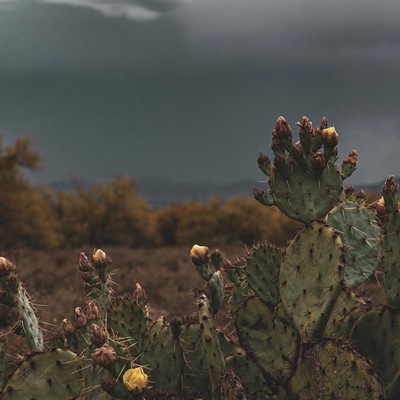These are not, however, the fresh pumpkins, squash and cranberries you hope to find on your holiday groaning board. For his pungently colored digital prints, on display at the Alliance Bank of Arizona in his first Tucson show in years, Lehrer selects only bruised produce in assorted stages of decay. You might be able to eat the browning bananas in "Vanitas X: Musa Paradisiaca," and one or two of the apples in "Vanitas V: Genus Malus," if you bite around the bad spots, but you'd definitely want to stay away from the disintegrating red pepper in "Vanitas IV: Piper Nigrum."
Something's rotten here, and that's the point. As his lofty Latin titles indicate, Lehrer is gamely jumping into an old art history tradition. In their vanitas ("vanity") still lifes, the Dutch painters of the 16th and 17th centuries used their objects both literally and metaphorically. A painting might actually be about a particular deceased rabbit culled from a nobleman's hunt, or of a shimmering glassy-eyed fish, but it was also about the inevitabilities of life and death. As the rabbit goes, so go we.
Following the Old Masters' lead, Lehrer first of all depicts objects that are alluring in themselves. His fruits and veggies are wonderfully hued, all bruise brown and sickly yellow and putrefying purple, and they're placed against plain backgrounds whose own colors pump up the composition. Particularly resonant is the rich earth-green backdrop of "Vanitas IX: Citrus Aurantium"; it reverberates beautifully against the vibrant color of four spent oranges. This little jewel may not be a Vermeer, but it's a beauty.
And Lehrer's objects are interestingly shaped, curving into space, like that banana, or collapsing into themselves. But they're also symbols of the passage of time, of life ripening, then decaying, then ending.
The photographer has worked these themes for a long time, but as far as I know, this is the first time he's deployed them in still life. In one earlier series, he pictured the decline of the Great Plains, photographing old farm buildings tumbling into ruin on the vast, empty prairie. In another, he probed archaeological sites of ancient cultures, the pyramids and temples of ancient Mexico, Egypt, Israel, crumbling Ozymandias-like into the sands.
These earlier works were all classic black-and-white, shot on film, and printed in gelatin silver. A couple of years ago, with some trepidation, Lehrer began switching to digital, and color. He's included a few transitional works. "Warrior," a dying saguaro shot in black and white in 1999, reappears here as an inkjet print, still in black and white. And "Yellowstone Gold," a near abstraction of autumnal colors, was shot as a Type C color photo, but printed via inkjet.
In the current show, Lehrer has gone wholeheartedly to the other side of the digital divide, what some photographic purists unabashedly call the dark side. But he's easily made the leap to color, and the digital images are amazingly detailed. Just look at the pores on those oranges.
Less interesting than the 12 Vanitas pictures are the two other series included in the narrow bank gallery, which is more corridor than showroom. "First Light in the 'Hood" and "Postcards From the Strip" are both street photography projects, zeroing in on fragments of architecture set among bits of controlled nature, one in Lehrer's foothills neighborhood and one in Las Vegas.
Lehrer writes poetically about the "bright, thin, mysterious light" of his early-morning strolls with his little dog in an older subdivision of the Catalinas. No one else is up and about, so the pictures capture pieces of houses, of gates, of garage doors. The overwhelming feeling is of anomie and isolation.
In "Order," the two wide doors of a triple garage painted blinding white march horizontally across the middle of the photo. Three small evergreen plants are confined in blocky white planters that would appeal only to a military mind, and a row of putatively decorative stones are lined up with regimental precision across the dull gravel. Elsewhere, in "Celestial Eye," a surveillance camera is placed precisely between two windows of another blazing white house, and just atop an agave so symmetrical it's hard to believe Mother Nature grew it that way.
The dispiriting conformity of contemporary housing gives way to Las Vegas' hustle and bustle. Or so you would think. In Lehrer's hands, Las Vegas has the same kind of dull uniformity as the suburbs, its slick new hotel towers nearly overwhelming old-time vernacular signs about circuses, Jesus and paradise. A McDonald's golden arch intrudes on the Jesus billboard in "Of Tidings and Tides," while a modern skyscraper dominates a goofy gold-painted statue of a tumbler in "Clarion." Nature in Las Vegas is limited strictly to manicured palms.
Lehrer makes legitimate points with this material, skewering the corporate dreck that is bollixing up our built environment, but the images are hard to look at. Viewing them feels a little like driving up Eyesore Road, better known as Oracle Road, where big-box stores launch their various visual assaults. Or it's like cruising through one of those deadly subdivisions whose rows upon rows of garage doors look like nothing so much as graves. Likely, Lehrer intended to make us uncomfortable. But given a choice between a taco deco house and old oranges, I'll take the rotten fruit any day.














